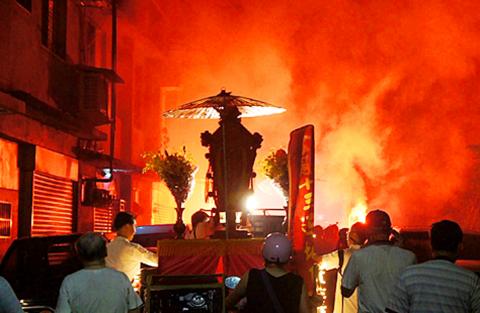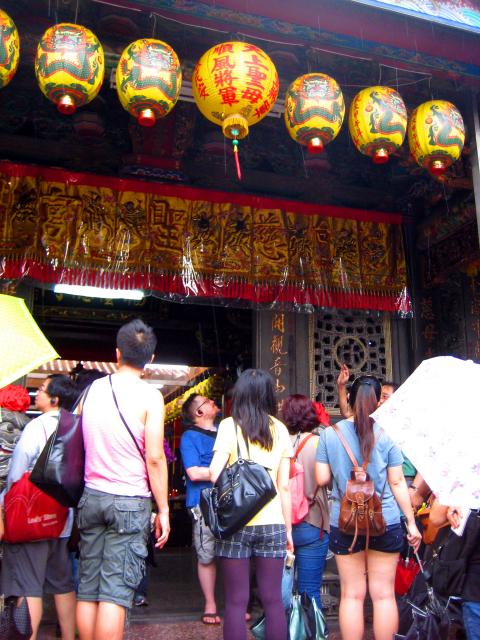In the midst of bustling Taipei lies a historical oasis where clusters of shops and homes are a reminder of what was once “the most important port in northern Taiwan.” What might be a little-known piece of history to non-Taiwanese is set to change with a series of walking tours introducing the region that is offered in English and Japanese.
The tours are held by Taipei Walking Tour in the Dadaocheng (大稻埕) and Dalongdong (大龍峒) districts, about 10 minutes north of Taipei Railway Station by car. Throughout May and June, a number of themed tours and workshops on topics such as Taiwan’s puppet culture, Xiahai City God Temple’s (霞海城隍廟) daytime and nighttime processions, and a roadside banquet on Dihua Street (迪化街) will be offered for NT$200 and NT$400. The tours and workshops are held mostly on the weekends leading up to the festival at Taipei Xiahai City God Temple, beginning on June 8.
In the past two years, veteran interpreter Joey Ho (何良正) has witnessed a growing interest among young people in Taiwan’s history.

Photo courtesy of Taipei Walking tour
“It could be the Internet that attracts young people to come and listen. Before, it seemed like young people weren’t interested in history. But through our efforts, they are starting to be concerned about this place, Taiwan’s history, its relics and old streets.”
With roughly 20 people following tour guide Johnny Cheng (程華生), the Dadaocheng heritage tour began with a stroll under the red arcade facade reminiscent of European architecture. Many of these former shops were built in the late 19th century, which coincided with Japanese occupation of Taiwan from 1895 to 1945. As a result of the marriage of European-Baroque, Japanese and Minnan (Southern Fujian) architectural styles, the buildings lining the streets are distinctly unique to Taiwan.
Prior to the tour, Kelly Hsiao (蕭凌雲) said she knew little about Dadaocheng’s history as a prosperous riverside town. Hsiao runs a hostel and was looking for recommendations to travelers other than the usual shopping and night market experience.

Photo: Jenny Peng
“When you visit Europe [and] stay in a hostel, they provide so many free tours or walking tours... [B]ut in Taiwan... we don’t have so many local activities to join for foreigners.”
Hsiao doesn’t know any other English-language walking tours available, and she thought it was “sad” that Taiwan’s history wasn’t easily accessible to non-Taiwanese.
One of the surprise stopovers was a tour led by a descendant of Lin Lan-tian (林藍田), one of Dadaocheng’s first settlers. Lin’s residence, built in the mid-1850s, is an example of Minnan architecture, designed for doing business. It’s unusually long depth is broken up into three sections. Supplies would arrive in the rear, while living corridors were in the middle and the front was a shop.
“It’s a legacy,” said Scott Lin (林宗志). “The spirit and wisdom of that legacy is something we’re trying to pass on to future generations.”
Although Scott Lin’s ancestors made a living selling mixed goods and offering fortune telling services, the shop has become a modern tea house, hinting at Dadaocheng’s past as a renowned tea processing center. Today, however, dried goods and Chinese herbal medicine are the two most common businesses in the neighborhood, according to Cheng.
The two-hour tour also included stopovers at Ci Sheng Temple (慈聖宮) and Xia Hai City God Temple.
Though attracting non-Taiwanese was the original goal of organizers, the majority of participants on Sunday were Taiwanese.
Yang Jei (楊乃傑) said he enjoyed the tour.
“I am Taiwanese, but I never knew this part of our history.”
For comprehensive information about the tours in Chinese, Japanese and English, visit: www.taipei-walkingtour.tw.

US President Donald Trump may have hoped for an impromptu talk with his old friend Kim Jong-un during a recent trip to Asia, but analysts say the increasingly emboldened North Korean despot had few good reasons to join the photo-op. Trump sent repeated overtures to Kim during his barnstorming tour of Asia, saying he was “100 percent” open to a meeting and even bucking decades of US policy by conceding that North Korea was “sort of a nuclear power.” But Pyongyang kept mum on the invitation, instead firing off missiles and sending its foreign minister to Russia and Belarus, with whom it

When Taiwan was battered by storms this summer, the only crumb of comfort I could take was knowing that some advice I’d drafted several weeks earlier had been correct. Regarding the Southern Cross-Island Highway (南橫公路), a spectacular high-elevation route connecting Taiwan’s southwest with the country’s southeast, I’d written: “The precarious existence of this road cannot be overstated; those hoping to drive or ride all the way across should have a backup plan.” As this article was going to press, the middle section of the highway, between Meishankou (梅山口) in Kaohsiung and Siangyang (向陽) in Taitung County, was still closed to outsiders

President William Lai (賴清德) has championed Taiwan as an “AI Island” — an artificial intelligence (AI) hub powering the global tech economy. But without major shifts in talent, funding and strategic direction, this vision risks becoming a static fortress: indispensable, yet immobile and vulnerable. It’s time to reframe Taiwan’s ambition. Time to move from a resource-rich AI island to an AI Armada. Why change metaphors? Because choosing the right metaphor shapes both understanding and strategy. The “AI Island” frames our national ambition as a static fortress that, while valuable, is still vulnerable and reactive. Shifting our metaphor to an “AI Armada”

The Chinese Communist Party (CCP) has a dystopian, radical and dangerous conception of itself. Few are aware of this very fundamental difference between how they view power and how the rest of the world does. Even those of us who have lived in China sometimes fall back into the trap of viewing it through the lens of the power relationships common throughout the rest of the world, instead of understanding the CCP as it conceives of itself. Broadly speaking, the concepts of the people, race, culture, civilization, nation, government and religion are separate, though often overlapping and intertwined. A government